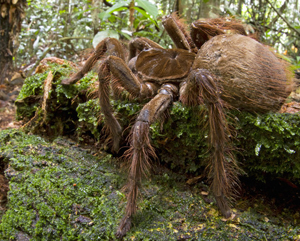Latest update November 7th, 2024 1:00 AM
Latest News
- Govt. hails US$1.5B gold project by Canadian firm
- Exxon says they are finalising area of Stabroek Block to hand back to govt.
- At least 38 people killed in dozens of Israeli strikes on eastern Lebanon
- Trump re-elected
- Citizens can no longer trust PPP, PNC to make decisions for a future with oil-Glenn Lall
World’s largest spider spotted in Guyana’s rainforest
Oct 22, 2014 News
Arachnophobes may want to steer clear of South American rainforests, where a Harvard University entomologist recently spotted the South American Goliath birdeater (Theraphosa blondi), the world’s largest spider.
Piotr Naskrecki, a photographer and entomologist at Harvard’s Museum of Comparative Zoology, was trekking through a rainforest in Guyana when he encountered the spider, which is roughly the size of a puppy.
According to Guinness World Records, the Goliath birdeater is the largest spider in the world, with a leg span up to 30 centimetres, or the size of a child’s forearm.
If the size of this colossal arachnid weren’t enough to spook arachnophobes, the sound it makes should be. “Its feet have hardened tips and claws that produce a very distinct, clicking sound, not unlike a horse’s hooves hitting the ground, but not as loud,” Naskrecki wrote on his blog.
Fortunately, the birdeater, which looks like a giant tarantula, does not pose a threat to humans. The spider’s venomous bite can do a great deal of damage to smaller mammals, but not to humans.
The bite, while not dangerous, would be painful. It would be “like driving a nail through your hand,” according to Naskrecki.
The spider’s sharp, 2-inch-long fangs aren’t its only defence mechanism, however. By rubbing its hind legs against its abdomen, the birdeater can emit a cloud of barbed hairs into the air. If the hairs get into the eyes, they can remain there for several days and cause itching and irritation.
The birdeater can also create a loud hissing sound by rubbing its front legs together to ward off potential enemies, a warning call that sounds “sort of like Velcro pulling apart,” said Naskrecki.
Even though this massive spider is named birdeater, it rarely feeds on birds. Because it does most of its hunting at night, it mostly feeds on earthworms, an abundant food source in Guyana’s humid nighttime climate.
That doesn’t mean other mammals are safe from the birdeater, however. Naskrecki explained that the birdeaters “will essentially attack anything that they encounter.”
According to Live Science, birdeaters are not common spiders. Naskrecki has been studying the tropics in South America for 10 to 15 years, yet he has only encountered the birdeater three times.
The last encounter with the birdeater has been fortunate for Naskrecki, who captured the spider and took it back to his lab to study. The spider is currently residing in a museum.
Share this:
- Click to print (Opens in new window)
- Click to email a link to a friend (Opens in new window)
- Click to share on Facebook (Opens in new window)
- Click to share on WhatsApp (Opens in new window)
- Click to share on Twitter (Opens in new window)
- Click to share on Pinterest (Opens in new window)
- Click to share on Pocket (Opens in new window)
- Click to share on Tumblr (Opens in new window)
- Click to share on Reddit (Opens in new window)
- Click to share on LinkedIn (Opens in new window)
Related
Similar Articles

The Glenn Lall Show | November, 6th, 2024
Follow on Tik Tok @Glennlall
THE BLUNT OF THE DAY

Sports
Nov 07, 2024
…Tournament kicks off November 20 kaieteur Sports- The Kashif and Shanghai Organisation, a name synonymous with the legacy of “Year End” football in Guyana, is returning to the local...Features/Columnists
A broad-based movement for the people’s voice on oil
…Peeping Tom Kaieteur News- The call for a referendum on Guyana’s oil contract is a step in the right direction,... more
Rising Gun Crimes in the Caribbean: Urgent Action required by all
By Sir Ronald Sanders Kaieteur News – There is an alarming surge in gun-related violence, particularly among younger... more
Publisher’s Note
Freedom of speech is our core value at Kaieteur News. If the letter/e-mail you sent was not published, and you believe that its contents were not libellous, let us know, please contact us by phone or email.
Feel free to send us your comments and/or criticisms.
Contact: 624-6456; 225-8452; 225-8458; 225-8463; 225-8465; 225-8473 or 225-8491.
Or by Email: [email protected] / [email protected]
Weekend Cartoon















